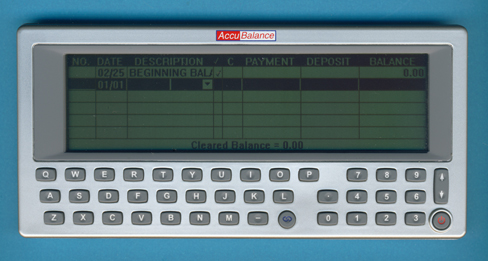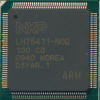
DATAMATH CALCULATOR MUSEUM
 |
DATAMATH CALCULATOR MUSEUM |
AccuBalance Corp. AccuBalance

![]()
 When
Canon introduced in 1988 the Checkbook
Recorder "Money Manager", it marked the eclipse of a series of Checkbook
Calculators initiated already in 1975 with the Corvus 525 - better known as
CheckMaster, brought to perfection with
the National Semiconductor NS103A and brought to the masses with products like
the Radio Shack EC-306 or
TI 2200 II.
When
Canon introduced in 1988 the Checkbook
Recorder "Money Manager", it marked the eclipse of a series of Checkbook
Calculators initiated already in 1975 with the Corvus 525 - better known as
CheckMaster, brought to perfection with
the National Semiconductor NS103A and brought to the masses with products like
the Radio Shack EC-306 or
TI 2200 II.
Fast forward and citing a patent application filed on December 2, 2003 by AccuBalance Corporation of St. Helena, CA:
|
ABSTRACT A method for reconciling a financial account of a user on a user device. A user list of transactions that have been entered by the user are accessed. A list of transactions from a financial institution is downloaded. The financial institution list is stored on the user device, and then compared with the user list, item by item. A reconciliation function is provided for each item on both of the lists.. |
AccuBalance Corporation was founded in November 2003 by Glenn Witherspoon in St. Helena, California with the clear mission to provide relief to millions of bank customers frustrated over the years with frequent checking account register errors and the dreaded end-of-the-month account reconciliation process. His extensive software development and Information Technology background, coupled with significant start-up and business development experience, provides the leadership and experience necessary to manage the development effort and bring AccuBalance to market.
Please find a press release of the U.S. Bank Market Trial with 1,000 AccuBalance units starting in September 2011 here.
The above mentioned "user device" was introduced in 2009 as AccuBalance, a Personal Digital Account Register, and it is pretty impressive! From the AccuBalance website, archived August 2009:
AccuBalance is finally here! A digital replacement for a paper register that fits in your checkbook wallet and keeps track of all account transactions, including debit card purchases, ATM withdrawals, checks, deposits, transfers, and fees. AccuBalance has touchscreen data entry, does all the math for you, and makes reconciling with your bank statement simple, quick, and accurate. No more overdraft fees! The number one recommendation
for detecting unauthorized transactions and identity theft is to reconcile your account often. AccuBalance is easier to use than a calculator!

 Architecture: Dismantling the AccuBalance manufactured in November 2010
reveals a modern architecture based on a NXP LH75411 microcontroller, formerly
Sharp Microelectronics LH7xxx series, mounted in a low-profile quad flat pack package with
144 pins and powered by a single 3.3 V supply. Additional main components on the
printed circuit board (PCB) are mostly memory devices and a USB to UART bridge. A second PCB provides the interface to the greyscale LC
Display.
Architecture: Dismantling the AccuBalance manufactured in November 2010
reveals a modern architecture based on a NXP LH75411 microcontroller, formerly
Sharp Microelectronics LH7xxx series, mounted in a low-profile quad flat pack package with
144 pins and powered by a single 3.3 V supply. Additional main components on the
printed circuit board (PCB) are mostly memory devices and a USB to UART bridge. A second PCB provides the interface to the greyscale LC
Display.
 Processor: The The LH75411 is a 16/32-bit System-on-Chip
(SoC) device centered around an ARM7TDMI-S core running at up to 84 MHz and
completed with 32k Bytes SRAM, Touch Screen Controller, 3 Serial Interfaces
(UART), Real-Time Clock, 3 Counters and Timers and a Color and Greyscale LCD
Controller.
Processor: The The LH75411 is a 16/32-bit System-on-Chip
(SoC) device centered around an ARM7TDMI-S core running at up to 84 MHz and
completed with 32k Bytes SRAM, Touch Screen Controller, 3 Serial Interfaces
(UART), Real-Time Clock, 3 Counters and Timers and a Color and Greyscale LCD
Controller.
Memory: The AccuBalance makes use of two different memory chips:
• NOR Flash-ROM
• SRAM
Flash memory is non-volatile and does not need a battery to maintain the
information stored in the chip. In the past years two different technologies
emerged in parallel with some advantages and disadvantages.
The disassembled AccuBalance makes use of one
M29W160EB, manufactured by STMicroelectronics, with a selectable 1M*16 or 2M*8 (2M Bytes) organization. The disassembled AccuBalance makes use of one Samsung K6X4008TIF SRAM with
a capacity of 512k Bytes.
Display: The AccuBalance uses a high-contrast display with a
resolution of 480 * 128 pixels. The NOR Flash-ROM was invented by Toshiba in 1984 and found its way
immediately as a replacement of the more expensive ROM (NRE mask costs) and
EEPROM (device costs) memory. The NOR Flash-ROM's use an address and data bus
to allow the random access to any memory location. Main disadvantages of the NOR
Flash-ROM compared to the NAND Flash-ROM are the higher costs, larger housings
and slower write speeds.
The NOR Flash-ROM was invented by Toshiba in 1984 and found its way
immediately as a replacement of the more expensive ROM (NRE mask costs) and
EEPROM (device costs) memory. The NOR Flash-ROM's use an address and data bus
to allow the random access to any memory location. Main disadvantages of the NOR
Flash-ROM compared to the NAND Flash-ROM are the higher costs, larger housings
and slower write speeds.
 SRAM is the abbreviation of static random access memory and is
used as program and data memory for microprocessor systems.
SRAM is the abbreviation of static random access memory and is
used as program and data memory for microprocessor systems. USB: The AccuBalance a CP2102 USB to UART bridge manufactured by SILABS to communicate with the host computer. The USB port is additionaly used to charge the internal
PD2440 coin type lithium battery from Route JD providing 3.7 V and a capacity of
150 mAh.
USB: The AccuBalance a CP2102 USB to UART bridge manufactured by SILABS to communicate with the host computer. The USB port is additionaly used to charge the internal
PD2440 coin type lithium battery from Route JD providing 3.7 V and a capacity of
150 mAh.
|
AccuBalance Launches U.S. Bank Market Trial St. Helena, CA, September 6, 2011: AccuBalance Corporation, a leading provider of consumer banking solutions, announces the beginning of a one-month market trial with nine U.S. Bank branches in Madison, Wisconsin as well as two Schnucks in-store branches in St. Louis, Missouri. During the trial, 1,000 AccuBalance units will be supplied to new customers who open a U.S. Bank account and use their Visa Check Card. AccuBalance is the digital replacement for a paper register that fits in your checkbook wallet and keeps track of all account transactions, including debit card purchases, ATM withdrawals, checks, deposits, transfers, and fees. The easy-to-use device has touchscreen data entry, does all the math for you, and makes reconciling with your bank statement simple, quick, and accurate, thus eliminating overdraft fees. The number one recommendation for detecting unauthorized transactions and identity theft is to reconcile your account often, and AccuBalance makes this quick and simple. With just a few clicks, you can upload your transaction history to financial management software like Quicken or MS Money, eliminating the need for double-entry of transactions. “We are very excited about AccuBalance’s partnership with U.S. Bank and the opportunity to get our product in the hands of customers who have demonstrated a deep need for our solution,” stated President and Chief Executive Officer, Glenn Witherspoon. “We believe that AccuBalance has the potential to revolutionize consumer banking, and the continued support from partners like U.S. Bank only reaffirms this confidence.” To learn more about the AccuBalance market trial with U.S. Bank, please call your nearest participating U.S. Bank branch or visit www.accubalance.com. |
If you have additions to the above article please email: joerg@datamath.org.
© Joerg Woerner, March 3, 2020. No reprints without written permission.